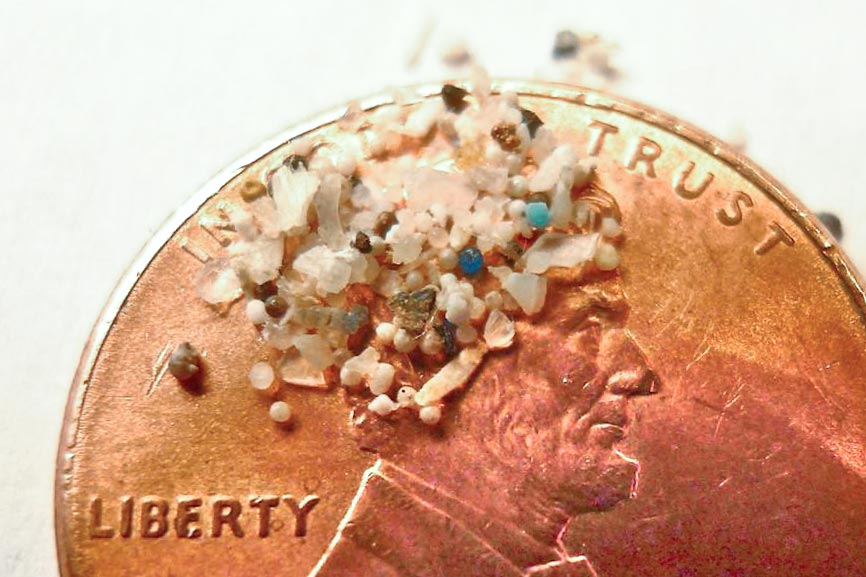Let’s talk microplastics. You’ve probably heard the buzz about microbeads by now, the tiny pieces of plastic that can be found in exfoliating facial scrubs, toothpaste, and other personal care products we use every day. It’s been a hot topic since the White House passed the Microbead-Free Waters Act of 2015, which phases out the use of microbeads in rinse-off cosmetic products beginning in 2017. So what’s wrong with microbeads? Why must we scrub ourselves instead of relying on the power of convenient little plastic balls to do all the work? I did some research and asked my co-worker Chris Burbage, an Environmental Scientist at HRSD, to give me the low-down on microplastics and explain why these tiny things are such a big threat.
First, some definitions. Microplastics are tiny pieces of plastic less than 5 mm in size that start out in different forms. Some microplastics start out as microbeads in our personal care products, but others were previously microfibers in textiles, scrubbers used for industrial cleaning, or pellets used as the raw material for all types of plastic products. Others are simply larger pieces of plastic that have broken down into smaller pieces. The problem with microplastics is they end up in our waterways where they become marine debris (AKA litter). Have you heard of the Great Pacific Garbage Patch? You might be visualizing a pile of floating trash but most of this “patch” is made up of microplastics under the surface. Even microplastics washed down the drain in your toothpaste or from your laundry can make it out in the environment because wastewater treatment plants are not designed to capture these tiny beads and fibers. It’s not as obvious as a disposable water bottle floating in a river, but it’s still litter and four things make these petite plastics particularly nasty once they reach the water:
- Plastic degrades slowly.
- They can release contaminants into water.
- Contaminants in polluted water can attach to them.
- Some of them look just like fish food.
So along comes Mr. Fish and he gobbles up what he believes to be a tasty meal, but what are actually chemical-laden microbeads. Sounds bad for the fish, but it could also be bad for anyone who eats him, because some of these chemicals can build up in animals along the food chain. If you are the seafood-loving type, this bioaccumulation could potentially land a nice little cocktail of chemicals on your dinner plate. In the case of microbeads, it was an easy call – keep them out of products – which is exactly why the Microbead-Free Waters Act sailed through Congress. Threat neutralized. Kind of.
This Act addresses microbeads in rinse-off products, but what about the other sources of microplastics? Some are tiny fibers that come off our clothes in the washing machine. They are too small to see, but in some marine environments they are more abundant than larger plastic litter. These fibers can also work their way up the food chain, but how do you stop invisible-clothing-fiber-pollution? I was happy to give up personal products with microbeads, but now my athletic wear is a problem? Check your closet for synthetic materials like polyester; polyester = plastic! When is the last time you steam-cleaned your carpet? Carpet fibers = microplastics full of those lovely carpet chemicals. Down the drain they go and like little ninjas they sneak right past even the best of us.
You can read a summary of what we know and don’t know about microplastics in our region in the recent Technical Review of Microbeads/Microplastics in the Chesapeake Bay by the Chesapeake Bay Program’s STAC. Or you can just go by my Cliffs notes version, which boils down to: Microplastics are not a threat to our drinking water because our drinking water is cleaned using methods that can filter out extremely small particles; however, microplastics are in waterways here in Hampton Roads and they are found in aquatic animals that we eat, such as oysters and fish. We still need to find out how much is in the Chesapeake Bay watershed, how they are impacting the environment, and how they are impacting our health.
While scientists work to answer these questions and we wait for microbeads to be removed from the shelves, we can reduce the number of microplastics out there by keeping our communities free of plastic litter and limiting microbead use in our own homes. You won’t find “microbeads” in any ingredient list (that would make it too easy), but there are still a few tricks you can use:
- Avoid products containing “polyethylene” and “polypropylene,” which are both types of plastic.
- Use an App to check products on the go, like Plastic Soup Foundation’s Beat the Microbead.
- Go straight to the source and buy from a local small business that values sustainability, like Chesapeake-based Roses Ridge Farm (one of my faves). You’ll be supporting an environmentally responsible business and your community.
- Make your own personal care products. Head to Pinterest and you’ll find all kinds of recipes from scrubs to toothpaste.

